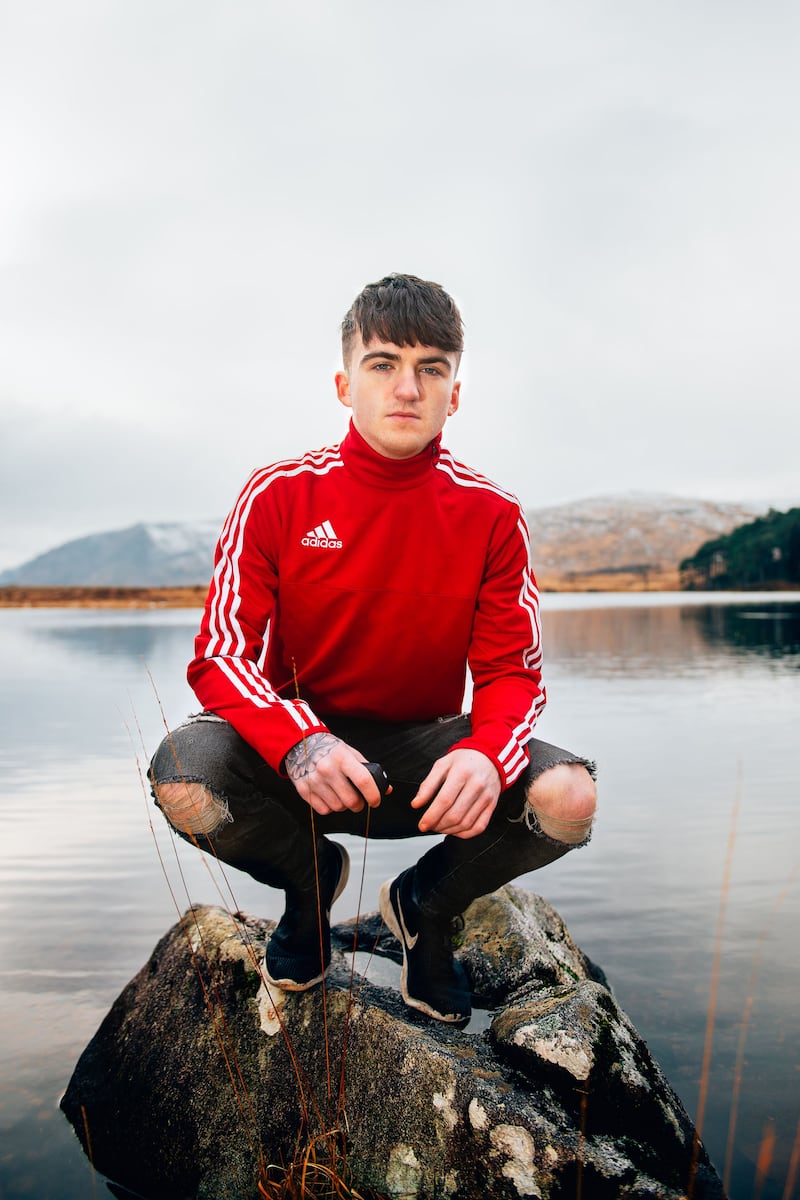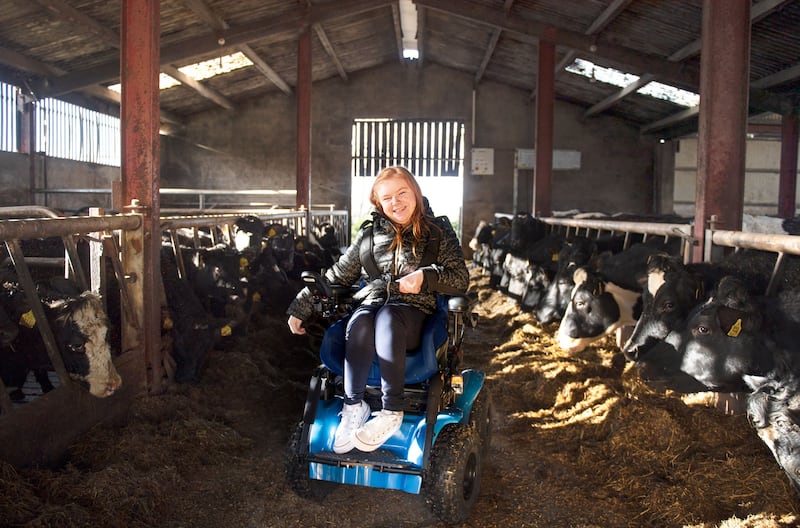In his larger-than-life size photographic portrait, Anthony Foy is looking straight to camera. He's squatting on a rock at the edge of a lake in Glenveagh National Park in Donegal, knees poking out of ripped jeans. In his hands he's holding a camera trigger. Foy chose the background, and the moment.
“When we were there, I decided I wanted it taken on that rock. I liked the calm of the water and the light on the hills behind.”
Foy looks like a young man who knows exactly what he’s about. But he hasn’t always felt that way. He’s had depression and anxiety, but now wants to speak out to encourage other young people with mental health issues.
His portrait is part of an exhibition called Facing Change, which opens at the Gallery of Photography in Temple Bar in Dublin on April 10th and will also tour the country. It's the brainchild of Genio, an organisation originally funded by Atlantic Philanthropies, which has been working to personalise social services. Foy has been involved in research to improve mental health services for young people in the northwest as part of one of Genio's projects.
I didn't think I would be able to do it, to stand up and say what needs to be done, but I built up my confidence over time
“One thing young people need is better transport so people can get to appointments. Or brighten up the waiting rooms when you are waiting to see someone,” he says.
“I was a long time at home, isolated, not wanting to go out. I didn’t think I would be able to do it, to stand up and say what needs to be done, but I built up my confidence over time.”

The exhibition's photographer, Ruth Medjber, is more likely to be found travelling the world with Arcade Fire, or photographing stars at Glastonbury and Electric Picnic. But for this project she travelled all over Ireland, photographing 10 people whose lives have been changed by this new approach.
“What I think that photograph says, is that Anthony is a force to be reckoned with,” says Medjber. “He’s only 19 but he has a strong head on his shoulders.”
Another one of Medjber’s sitters was Ruby McCandless, who lives on the Inishowen peninsula. “Another 20 miles and you’d fall off the island,” says her father Alan. When he learned that his daughter Ruby, who’s now 13, had cerebral palsy, it was a massive shock.
“It takes a long time to sink in. You’re vulnerable and you don’t want to talk about it.”
Through a local organisation called Spraoi agus Sport, he and his wife Chrissy began to meet other parents in similar situations. Based in Carndonagh, it's one of the organisations being funded by Genio to support people with disabilities to live in their communities, and give them a degree of independence.
“We’re very remote out here, so children with disabilities are quite isolated. But now there’s a bus that will pick Ruby up and bring her to different activities – art, sport, swimming. They asked Ruby what she was into, and they send out a text about what’s on and you can book a slot.”

The photographer made the whole day about Ruby, and she really enjoyed it
Medjber took Ruby’s photograph in her favourite place to hang out.
“We initially met up in the centre that Ruby goes to,” says Medjber. “But then she said she loved being in the cowshed at home on the farm. I was, like, what are we doing here? Let’s go!”
Ruby’s dad says: “The photographer made the whole day about Ruby, and she really enjoyed it. Ruby is all into her clothes and her hair. If you go shopping with her it takes forever because she talks to everyone.”
That connection with the community, being part of everyday life, is at the heart of Genio’s work. Some of the projects, which operate through the Service Reform Fund, involve collaborating with the HSE to help people move out of institutional care into the community.
As we pull up at a bungalow on a quiet country road near Monasterboice in Co Louth, David Doyle is already at the door to welcome us into his home. The house is spotless. “I’ve been doing the hoovering, cleaning the shower this morning,” says Doyle, who has lived here for a year with three other men.
Before that, Doyle, who has an intellectual disability, lived in the St John of God residential institution in Drumcar, which has been the subject of critical reports from Hiqa.
The kettle is on and the good cups are on the table. Yesterday, Doyle picked up some cupcakes and chocolate chip cookies at the supermarket because he knew we were coming. As we chat, a black and white cat is visible in the garden, sheltering under a hedge.
“That’s Banno,” says Doyle. He jumps up to fetch the cat food in the utility room, fills a dish and opens the back door. Banno runs away when I approach, but is happy to be stroked by Doyle, who encourages him to come to the dish and eat.
While people have been moving into group homes for several decades, the Genio approach focuses on personalising services for the individual, so that they take the lead in their daily life.
“It’s really noticeable that David smiles more, and is so much more independent,” says staff member Roisín Sweeney. “He has a valued role within the house. There’s space for his stuff, and he can have a pet which wouldn’t have been possible before.”
Doyle features in the video that accompanies the photo exhibition, taking evident pleasure in daily tasks like preparing dinner, after half a lifetime of eating food served from a bain-marie. He also has an occasional pint in the local pub, goes to Mass in nearby Fieldstown on Sundays, has lost a stone at Slimming World, and can order a takeaway on a Saturday night, things that the rest of us take for granted.
But moving people into the community isn’t without its challenges.
“There were people with family members who had been in Drumcar for 50 years. It was all they’d known,” says Paula Doyle, who has been one of the leaders involved in the transition.
“They had genuine concerns and anxieties about it. But now what you see is that families visit more, and they bring their children with them. It was probably off-putting to go into that campus setting.”
I was never going to photograph people in a way that focuses on a disability. I try to make people look like the rock stars that they are
Since the collaboration between Genio and the HSE began 10 years ago, 835 people with intellectual disabilities have been supported to move into the community, and 19 residential institutions have been closed down.
“The HSE has been working to get us into Áras Attracta and other high-profile places where things haven’t been as good as they should be”, says Madeleine Clarke, executive director of Genio. “People are moving out. But when you have people in an institution, you can’t stop paying for it until the last person leaves and you turn out the lights. You have to do it in stages, so what we’re doing is bridging finance really.”
The exhibition also includes portraits of individuals who were homeless, or who have dementia, who have been supported to live self-directed lives in the community.
Ruth Medjber says she started off thinking it would be cool to have an exhibition in the Gallery of Photography, but has ended up becoming deeply personally involved.
“It taught me a lot about how varied other people’s lives are, and how strong people are in a way I didn’t know was possible.”
Right now, what’s most important to her is that the sitters love their photographs.
“I was never going to photograph people in a way that focuses on a disability. I try to make people look like the rock stars that they are.”








